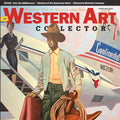Early 20th Century Artists: Drawn By A Desert Icon
By Medicine Man Gallery on
Early 20th Century Artists: Drawn By A Desert Icon
By Victoria Chick
Courtesy Big Blend's Parks & Travel Magazine, April 2018
The tall saguaro cactus with its many arms is an icon representing all deserts to most Americans and people from other countries. Yet, the saguaro is found mainly in the Sonoran desert of Arizona and Mexico in a band whose northern edge is roughly parallel with the city of Tucson. A small area of saguaro cacti can also be found in the lower Imperial Valley of California and some naturally occurring saguaros can be found in the Phoenix area.
Settlers moved into the area we now call Arizona as early as the mid-19th century. By the time Arizona became a state in 1912, there was already a large group of well-known artists, both men and women, working within its boundaries.
Most artists lived in the cool, well-watered, northern Arizona mountains. Some of the artists traveled to and painted in other southwest states as well. In the winter, the Sonoran Desert became a favorite subject due, in part, to the drop in temperature to a comfortable level. The other reason for artists to visit the Sonoran Desert was the dramatic change in scenery and plant life, including the majestic saguaro cactus. Artists included the saguaro in oil paintings, watercolors, and etchings that found favor with Easterners for the exotic and romantic content of their landscapes. The paintings and etchings of these early artists account for the widespread, erroneous notion that if it is a desert, saguaro must grow there.
The ability to remain comfortable in southern Arizona desert areas changed after WWII when the development of air conditioning made low desert communities comfortable in the summer. More artists came and a great increase in year round residents created a local market for Arizona art. Up to this point in time, Arizona artists with East Coast connections marketed their paintings by shipping them to dealers in New York, Boston, and Philadelphia.
There are five desert artists, famous in their own time, of whom you may not have heard. Although there were many self-taught cowboy artists in Arizona in the 19th and early 20th century, they were outnumbered by pioneer women from the East who had some classical art training. The Prescott area had at least a dozen professional women artists who met and supported each other’s endeavors.
Kate Corey, Mable L. Lawrence, Claire Doone Phillips, Ada Rigdon, Jesse Benton Evans, and Lillian Wilhelm Smith are some of the women who painted professionally during Arizona’s Territorial years. Lillian Wilhelm Smith is an outstanding example from this group.
Lillian Wilhelm Smith’s life began in Germany, but she immigrated to New York with her parents as a young child. Her advanced skills in drawing earned her a place studying at the NY Art Students League when she was only 12.
She was determined to lead an unusual life for a woman of her era by foregoing marriage and children and, instead, pursuing an art career. Aiding her in this endeavor was her cousin-inlaw, a young novelist named Zane Grey. Grey introduced her to the “wild west” at a Buffalo Bill Wild West Show in New York and arranged for her to draw and paint the Indians in that show.
Grey had great confidence in Wilhelm Smith’s skills as an artist and when he went to Arizona in 1913 on an expedition to find locations on Navaho lands and material for his new set of novels, he asked her be his illustrator. This expedition was supposed to be too rough for a woman, especially one with no horseback riding experience. Wilhelm Smith was befriended by the guide who gave her advice to make the 400 mile trip as comfortable as possible.
Back in New York for several years, she tired of the modernist trends being introduced and decided to return to the Phoenix, Arizona area to live in 1916, where she continued to paint in oils and watercolors. Many of her paintings are of distinctive geographical places in Arizona and incorporate desert vegetation, including the saguaro.
Two artists with long careers shared early backgrounds in newspaper illustration and cartooning.
A native Californian born in 1875, illustrator Maynard Dixon made his first Arizona visit in 1900, and it fueled his drive to be a western painter. Awed by the mountain shapes, shadows, and cloud formations, Dixon eventually simplified his compositions, and expressed himself with strong color and contrast. By 1930, he was spending his winters in Tucson and summers in Utah. Although he did not live a long life, his art production was prolific and his painting style continues to inspire western artists.
Hearst newspaper cartoonist, James (Jimmy) Swinnerton, worked in New York until he was diagnosed with tuberculosis and was given a short time to live. Hearst, his friend as well as his employer, sent him to California for treatment in a better climate. Surprisingly, he improved, and began taking painting classes in San Francisco.
In the 1920’s he began painting trips that took him to deserts in California, Utah, and Arizona. He had a successful 45 year career as a desert painter. Swinnerton is recorded as saying, “Every minute in the desert is all new and completely different than anything that has been or will be. The difficult thing is to catch it quickly before the sands blow or shadows in the hills shift and create a new picture”. In his later years, Swinnerton lived and worked in Palm Desert, California, passing away at age 99.
Darwin Duncan is identified most often as a California painter of desert scenes but also spent time painting in southern Arizona. His favorite places there were near Tucson and in what is now the Organ Pipe Cactus National Monument. His need for a regular paycheck sidetracked his early career into drafting. But he met Sam Clyde Harris and Edgar Payne who invited him on painting trips into the Sierras and to whom he gave credit for his growth as an artist. Duncan was a generous teacher himself, taking students on paint-outs near Palm Desert, Palm Springs, and into the Anza Borrego Desert. His path may have crossed that of James Swinnerton when Duncan painted the dioramas for the Living Desert Museum in Palm Desert during the time Swinnerton resided there.
Albert Lorey Groll was both a painter and a printmaker originally from the East Coast, whose introduction to Arizona came in the early 1900s when he accompanied an ethnologist there. While the ethnologist studied Indian games, Groll sketched the landscape and cloud formations so different from those in the East. Groll’s desert subjects were very well received in Eastern art shows. There is not agreement among sources that he moved permanently to Arizona.
He felt a tremendous affinity for the desert and some sources say he moved to Arizona round 1905, even going so far as to adopt an Indian way of life. Other sources say he always maintained an art studio in New York and made periodic visits to Arizona and New Mexico. Whichever way it was, he became famous for his depictions of Arizona and is often credited with being the catalyst for making people recognize the beauty within the desert.
Another printmaker and painter, this time a watercolorist, was Gerry Peirce who moved from New York to Arizona around 1938 after spending several winters there. Peirce was initially an illustrator and, later, wrote and illustrated books on painting. He had art training from the Cleveland School of Art and the NY Art Students League, and also learned etching techniques while in Nova Scotia. In 1948, his interest turned to watercolor and he founded the Gerry Peirce School of Watercolor in Tucson. His work celebrates the intense Arizona sun, desert topography, plants, stormy summer skies, and architecture unique to the southwest.
A third printmaker, and one ahead of his time, was George Burr who made zinc plate etchings as a young man in Cameron, Missouri in the 1870s when etching was just beginning to be adopted as a medium among artists in New York and Philadelphia. Burr left working at his father’s hardware store to take classes at the Chicago Art Institute but, after only three months of classes, went on to a career in magazine illustration.
Beginning in 1892, his outstanding skills were put to use for the next four years making 1,000 detailed etchings of jade pieces in the Heber Bishop collection at the Metropolitan Museum of Art. He moved to Phoenix, Arizona in 1924 and spent the rest of his life there with the Arizona deserts and mountains as his subjects.
Arizona had many talented artists during its formative years. The artists in this article are only a sample of those early artists drawn to the rugged beauty of the deserts and that icon – the saguaro cactus.
If you would like more information or would like to see original work, visit an Arizona Gallery or Museum specializing in early Arizona artists - some include: Arizona State University Art Museum in Tempe; Phoenix Art Museum in Phoenix; Desert Caballeros Western Museum in Wickenburg; Maynard Dixon Museum in Tucson; Blue Coyote Gallery in Cave Creek; and Hubble Trading Post National Historic Site in Ganado, Arizona.



